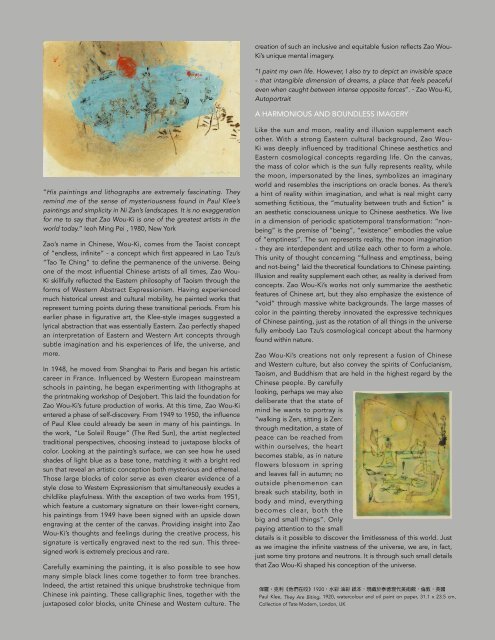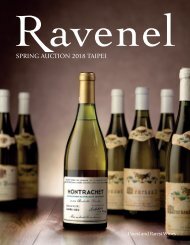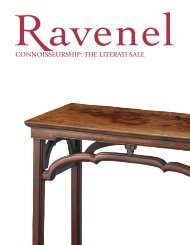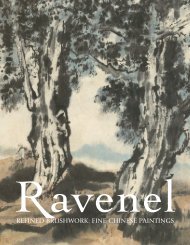亞洲現代與當代藝術 Modern and Contemporary Asian Art
羅芙奧2018春季拍賣會 亞洲現代與當代藝術 Ravenel Spring Auction 2018 Modern and Contemporary Asian Art
羅芙奧2018春季拍賣會 亞洲現代與當代藝術 Ravenel Spring Auction 2018 Modern and Contemporary Asian Art
Create successful ePaper yourself
Turn your PDF publications into a flip-book with our unique Google optimized e-Paper software.
creation of such an inclusive <strong>and</strong> equitable fusion reflects Zao Wou-<br />
Ki’s unique mental imagery.<br />
“I paint my own life. However, I also try to depict an invisible space<br />
- that intangible dimension of dreams, a place that feels peaceful<br />
even when caught between intense opposite forces”. - Zao Wou-Ki,<br />
Autoportrait<br />
A HARMONIOUS AND BOUNDLESS IMAGERY<br />
“His paintings <strong>and</strong> lithographs are extremely fascinating. They<br />
remind me of the sense of mysteriousness found in Paul Klee’s<br />
paintings <strong>and</strong> simplicity in Ni Zan’s l<strong>and</strong>scapes. It is no exaggeration<br />
for me to say that Zao Wou-Ki is one of the greatest artists in the<br />
world today.” Ieoh Ming Pei , 1980, New York<br />
Zao’s name in Chinese, Wou-Ki, comes from the Taoist concept<br />
of “endless, infinite” - a concept which first appeared in Lao Tzu’s<br />
“Tao Te Ching” to define the permanence of the universe. Being<br />
one of the most influential Chinese artists of all times, Zao Wou-<br />
Ki skillfully reflected the Eastern philosophy of Taoism through the<br />
forms of Western Abstract Expressionism. Having experienced<br />
much historical unrest <strong>and</strong> cultural mobility, he painted works that<br />
represent turning points during these transitional periods. From his<br />
earlier phase in figurative art, the Klee-style images suggested a<br />
lyrical abstraction that was essentially Eastern. Zao perfectly shaped<br />
an interpretation of Eastern <strong>and</strong> Western <strong>Art</strong> concepts through<br />
subtle imagination <strong>and</strong> his experiences of life, the universe, <strong>and</strong><br />
more.<br />
In 1948, he moved from Shanghai to Paris <strong>and</strong> began his artistic<br />
career in France. Influenced by Western European mainstream<br />
schools in painting, he began experimenting with lithographs at<br />
the printmaking workshop of Desjobert. This laid the foundation for<br />
Zao Wou-Ki’s future production of works. At this time, Zao Wou-Ki<br />
entered a phase of self-discovery. From 1949 to 1950, the influence<br />
of Paul Klee could already be seen in many of his paintings. In<br />
the work, “Le Soleil Rouge” (The Red Sun), the artist neglected<br />
traditional perspectives, choosing instead to juxtapose blocks of<br />
color. Looking at the painting’s surface, we can see how he used<br />
shades of light blue as a base tone, matching it with a bright red<br />
sun that reveal an artistic conception both mysterious <strong>and</strong> ethereal.<br />
Those large blocks of color serve as even clearer evidence of a<br />
style close to Western Expressionism that simultaneously exudes a<br />
childlike playfulness. With the exception of two works from 1951,<br />
which feature a customary signature on their lower-right corners,<br />
his paintings from 1949 have been signed with an upside down<br />
engraving at the center of the canvas. Providing insight into Zao<br />
Wou-Ki’s thoughts <strong>and</strong> feelings during the creative process, his<br />
signature is vertically engraved next to the red sun. This threesigned<br />
work is extremely precious <strong>and</strong> rare.<br />
Carefully examining the painting, it is also possible to see how<br />
many simple black lines come together to form tree branches.<br />
Indeed, the artist retained this unique brushstroke technique from<br />
Chinese ink painting. These calligraphic lines, together with the<br />
juxtaposed color blocks, unite Chinese <strong>and</strong> Western culture. The<br />
Like the sun <strong>and</strong> moon, reality <strong>and</strong> illusion supplement each<br />
other. With a strong Eastern cultural background, Zao Wou-<br />
Ki was deeply influenced by traditional Chinese aesthetics <strong>and</strong><br />
Eastern cosmological concepts regarding life. On the canvas,<br />
the mass of color which is the sun fully represents reality, while<br />
the moon, impersonated by the lines, symbolizes an imaginary<br />
world <strong>and</strong> resembles the inscriptions on oracle bones. As there’s<br />
a hint of reality within imagination, <strong>and</strong> what is real might carry<br />
something fictitious, the “mutuality between truth <strong>and</strong> fiction” is<br />
an aesthetic consciousness unique to Chinese aesthetics. We live<br />
in a dimension of periodic spatiotemporal transformation: “nonbeing”<br />
is the premise of “being”, “existence” embodies the value<br />
of “emptiness”. The sun represents reality, the moon imagination<br />
- they are interdependent <strong>and</strong> utilize each other to form a whole.<br />
This unity of thought concerning “fullness <strong>and</strong> emptiness, being<br />
<strong>and</strong> not-being” laid the theoretical foundations to Chinese painting.<br />
Illusion <strong>and</strong> reality supplement each other, as reality is derived from<br />
concepts. Zao Wou-Ki’s works not only summarize the aesthetic<br />
features of Chinese art, but they also emphasize the existence of<br />
“void” through massive white backgrounds. The large masses of<br />
color in the painting thereby innovated the expressive techniques<br />
of Chinese painting, just as the rotation of all things in the universe<br />
fully embody Lao Tzu’s cosmological concept about the harmony<br />
found within nature.<br />
Zao Wou-Ki’s creations not only represent a fusion of Chinese<br />
<strong>and</strong> Western culture, but also convey the spirits of Confucianism,<br />
Taoism, <strong>and</strong> Buddhism that are held in the highest regard by the<br />
Chinese people. By carefully<br />
looking, perhaps we may also<br />
deliberate that the state of<br />
mind he wants to portray is<br />
“walking is Zen, sitting is Zen:<br />
through meditation, a state of<br />
peace can be reached from<br />
within ourselves, the heart<br />
becomes stable, as in nature<br />
flowers blossom in spring<br />
<strong>and</strong> leaves fall in autumn; no<br />
outside phenomenon can<br />
break such stability, both in<br />
body <strong>and</strong> mind, everything<br />
becomes clear, both the<br />
big <strong>and</strong> small things”. Only<br />
paying attention to the small<br />
details is it possible to discover the limitlessness of this world. Just<br />
as we imagine the infinite vastness of the universe, we are, in fact,<br />
just some tiny protons <strong>and</strong> neutrons. It is through such small details<br />
that Zao Wou-Ki shaped his conception of the universe.<br />
1920 <br />
Paul Klee, They Are Biting, 1920, watercolour <strong>and</strong> oil paint on paper, 31.1 x 23.5 cm,<br />
Collection of Tate <strong>Modern</strong>, London, UK







